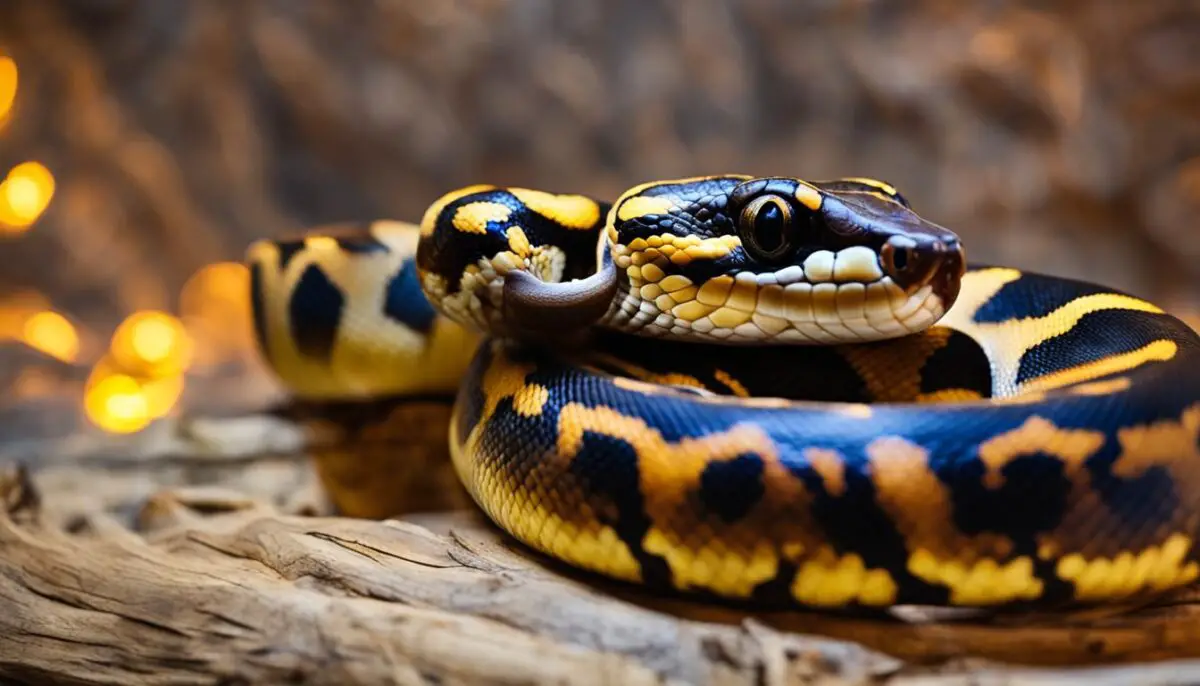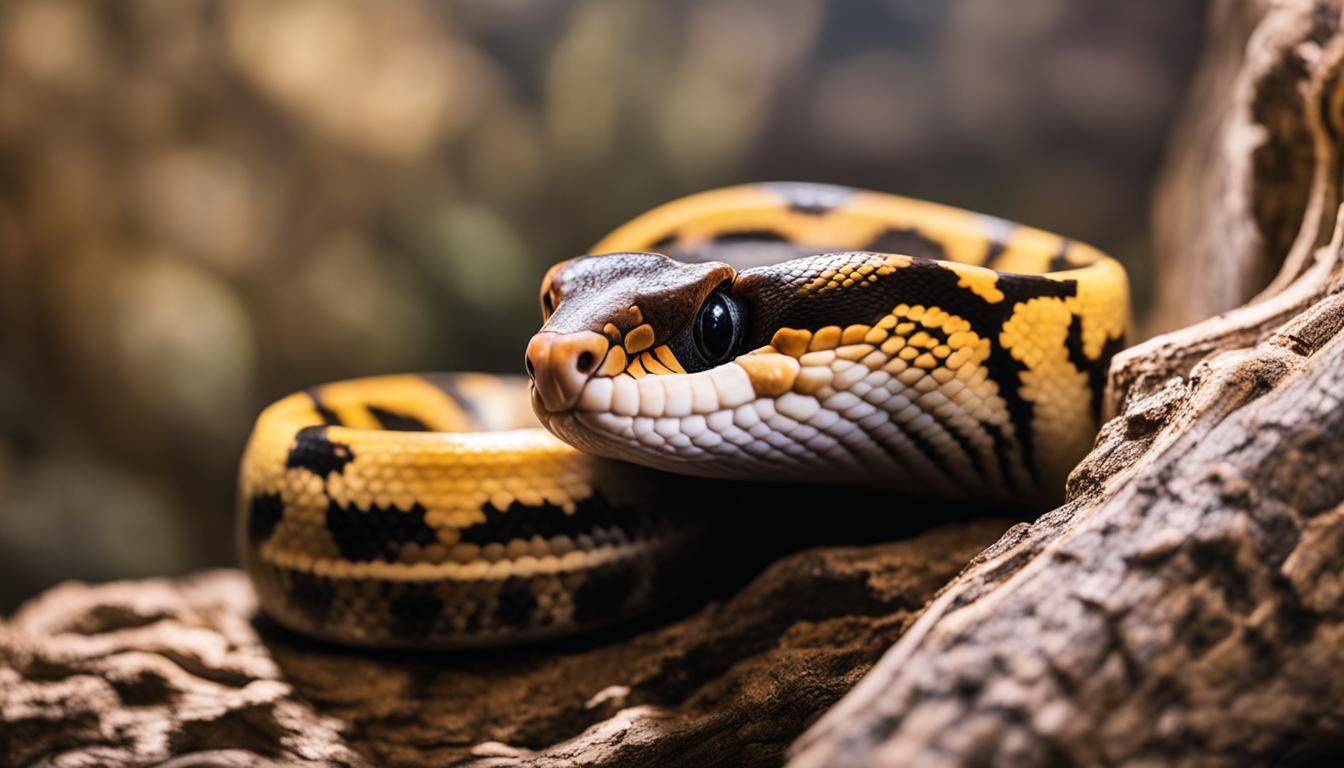Do ball pythons need UVB lighting? This is a common question among reptile enthusiasts. Ball pythons are fascinating creatures, known for their docile nature and striking appearance. However, when it comes to their lighting requirements, there is some debate.
Unlike many other reptiles, ball pythons do not require UVB lighting to survive. They are largely nocturnal and rely primarily on their sense of smell to navigate their surroundings. While UVB light is essential for the health of some reptiles, such as lizards, ball pythons can thrive without it.
Exposure to UVB light may even cause health problems in some cases. Therefore, it is not necessary to provide UVB light to ball pythons. However, some keepers choose to provide UVB lighting for its potential benefits.
Key Takeaways:
- Ball pythons do not require UVB lighting to survive.
- UVB light is essential for the health of some reptiles, but ball pythons can thrive without it.
- Exposure to UVB light may cause health problems in ball pythons.
- Some keepers choose to provide UVB lighting for its potential benefits.
- The decision to provide UVB lighting for ball pythons is a personal choice based on the individual snake’s needs and preferences.
The Benefits of UVB Lighting for Ball Pythons
While UVB lighting is not necessary for ball pythons, some keepers choose to provide it for its potential benefits. UVB light can mimic the natural sunlight that ball pythons would receive in the wild. It may help in synthesizing vitamin D3, which aids in calcium absorption and overall health. Additionally, UVB light can enhance the coloration and behavioral patterns of ball pythons. Keepers who provide UVB lighting have reported improved feeding response, increased activity, and overall better physical condition in their snakes. However, it is important to note that UVB lighting should be used cautiously, and proper measures should be taken to prevent overheating and ensure the snake’s safety.
“UVB light stimulates natural behaviors and can have a positive impact on the overall well-being of ball pythons.” – Dr. Samantha Wilson, Herpetologist
To illustrate the benefits of UVB lighting for ball pythons, consider the following advantages:
- Enhanced Vitamin D3 synthesis for improved calcium absorption and bone health
- Optimal color development, showcasing vibrant and striking patterns
- Increased activity levels, promoting a more active and engaging pet
- Improved feeding response, ensuring a healthy appetite and proper nutrition
- Enhanced overall physical condition, leading to a happy and thriving snake

| Benefits of UVB Lighting for Ball Pythons | Summary |
|---|---|
| Enhanced Vitamin D3 synthesis | Aids in calcium absorption and overall health |
| Optimal color development | Enhances vibrant and striking patterns |
| Increased activity levels | Promotes a more active and engaging pet |
| Improved feeding response | Ensures a healthy appetite and proper nutrition |
| Enhanced overall physical condition | Leads to a happy and thriving snake |
While UVB lighting offers these potential benefits, it is crucial to approach its usage with caution. Too much UVB exposure can lead to overheating and discomfort for your ball python. Therefore, it is important to provide shaded areas within their habitat and monitor their behavior closely when introducing UVB lighting.
Choosing the Right UVB Lighting Setup
When considering UVB lighting for your ball python, it is essential to choose the right setup to ensure their well-being. A 22″ long, low-intensity T5 HO fluorescent tube is recommended for a 4x2x2 enclosure. Coil UVB bulbs are not efficient and should be avoided. Brands like Arcadia and ZooMed are reliable options for UVB bulbs. It is important to use a light that produces a balanced spectrum without UVB for most cases. The UVB bulb should be mounted above the mesh or without any obstruction, and the distance should be adjusted accordingly to maintain the optimal UVB exposure.
Next, we’ll discuss how to establish a proper lighting schedule for ball pythons, ensuring their day-night cycle aligns with their natural behavior and promotes their well-being.
Choosing the Right Lighting Setup for Ball Pythons
If you decide to provide UVB lighting for your ball python, it is important to choose the right setup. Here are some key recommendations:
- Use a 22″ long, low-intensity T5 HO fluorescent tube for a 4x2x2 enclosure. This type of UVB light provides optimal coverage for your snake’s habitat.
- Avoid using coil UVB bulbs, as they are not efficient and may not provide adequate UVB exposure for your ball python.
- Consider trusted brands like Arcadia and ZooMed when selecting UVB bulbs. These brands are known for their quality and reliability.
- Choose a light that produces a balanced spectrum without UVB for most cases. This helps create a natural lighting environment for your snake.
- Mount the UVB bulb above the mesh or without any obstruction to ensure proper exposure. The distance between the bulb and your snake should be adjusted according to the manufacturer’s recommendations.
- Remember to change the UVB bulb every 6-12 months to maintain its effectiveness. Over time, UVB output diminishes, and it is important to provide your ball python with a consistently beneficial light source.
By following these recommendations, you can ensure that your ball python receives the appropriate UVB lighting for its health and well-being. Remember, it is essential to prioritize your snake’s safety and make informed choices when it comes to lighting their habitat.
Image:

Establishing a Lighting Schedule for Ball Pythons
Ball pythons, like many other reptiles, have specific lighting needs to ensure their health and well-being. Understanding their natural behavior and light requirements is essential for creating a suitable lighting schedule for these fascinating creatures.
The Importance of a Day-Night Cycle
Just like in the wild, ball pythons thrive on a natural day-night cycle. This cycle helps regulate their internal clock, influencing their activity levels and feeding patterns. Mimicking this day-night cycle is crucial in providing a comfortable and stress-free environment for your ball python.
While ball pythons are mostly nocturnal, they are also crepuscular, meaning they are most active during the early mornings and evenings. To simulate their natural habitat, it is recommended to provide a 12-hour on, 12-hour off lighting schedule.
By using a lamp timer, you can easily automate the day-night cycle, ensuring consistency and minimal disturbance to your snake’s routine. This regularity will help reduce stress and anxiety, promoting a healthy appetite and overall well-being.
Avoid Colored Bulbs for Night Viewing
When establishing a lighting schedule for your ball python, it is important to note that colored bulbs marketed for night viewing or supplemental heat are not necessary and may disrupt their day-night rhythm.
Ball pythons do not need additional light sources during the night as they prefer darkness to rest and feel secure in their enclosure. Using colored bulbs can confuse their natural perception of light and darkness, potentially leading to unnecessary stress.
Creating Shade and Darkness
In addition to providing an appropriate lighting schedule, it is crucial to ensure your ball python has access to shaded areas and darkness within its enclosure. This mimics their natural habitat and gives them the opportunity to retreat and feel secure.
Utilizing hides, such as cave-like structures or branches, can create these shaded areas within the enclosure. Remember that ball pythons are master escape artists, so ensure the hides are secure and provide enough space for them to comfortably curl up.
By establishing a proper lighting schedule and creating adequate shade and darkness, you can provide your ball python with an environment that closely mimics their natural habitat. This results in a happy, healthy, and content snake!
Conclusion
In conclusion, the provision of UVB lighting for ball pythons is a personal choice based on individual snake needs and preferences. While UVB lighting is not necessary for the survival of ball pythons, some keepers opt to provide it for potential benefits. UVB light can mimic natural sunlight, contributing to the overall health and well-being of these snakes.
It is crucial, however, to exercise caution when implementing UVB lighting and to ensure that the snake has access to shaded areas. Choosing the right lighting setup, such as a 22″ long, low-intensity T5 HO fluorescent tube, and establishing a proper lighting schedule, such as a 12-hour on, 12-hour off cycle, are essential for the snake’s comfort and well-being.
By providing UVB lighting, keepers may see improvements in the snake’s physical condition, feeding response, activity levels, and coloration. However, it is important to use reputable brands like Arcadia and ZooMed and to change the UVB bulb every 6-12 months to maintain its effectiveness.
In summary, while UVB lighting is not a requirement for ball pythons, it can offer potential benefits. The decision to provide UVB lighting should be made with care, considering the snake’s specific needs and ensuring that proper measures are taken to promote a healthy and enriched environment.
FAQ
Do ball pythons need UVB lighting to survive?
No, ball pythons do not require UVB lighting to survive. They are largely nocturnal and rely primarily on their sense of smell. UVB lighting is not necessary for their basic survival.
Are there any benefits of providing UVB lighting for ball pythons?
Yes, some keepers choose to provide UVB lighting for its potential benefits. UVB light can mimic natural sunlight, aid in synthesizing vitamin D3 for calcium absorption, enhance coloration and behavioral patterns, and improve overall health and well-being in ball pythons.
What should I consider when choosing the right lighting setup for ball pythons?
When selecting a lighting setup for ball pythons, it is recommended to use a 22″ long, low-intensity T5 HO fluorescent tube for a 4x2x2 enclosure. Avoid coil UVB bulbs and choose reputable brands like Arcadia and ZooMed. Make sure the UVB bulb is mounted above the mesh or without any obstruction, and adjust the distance accordingly. Remember to change the UVB bulb every 6-12 months for optimal effectiveness.
How should I establish a lighting schedule for ball pythons?
To mimic their natural environment, it is recommended to provide a 12-hour on, 12-hour off lighting schedule for ball pythons. Use a lamp timer to automate the day-night cycle and ensure consistency. This helps reduce stress, maintains the snake’s day-night rhythm, and ensures their willingness to feed.
Do ball pythons require a day-night cycle?
Yes, ball pythons are crepuscular and are most active at dawn and dusk. Providing a day-night cycle with a consistent lighting schedule is important for their well-being and helps regulate their behavior and feeding patterns.
What is the conclusion regarding UVB lighting for ball pythons?
UVB lighting is not necessary for the basic survival of ball pythons, but it can provide potential benefits for their overall health and well-being. Keepers should make the decision based on their individual snake’s needs and preferences, while ensuring proper setup, caution, and consideration of the snake’s comfort and safety.


